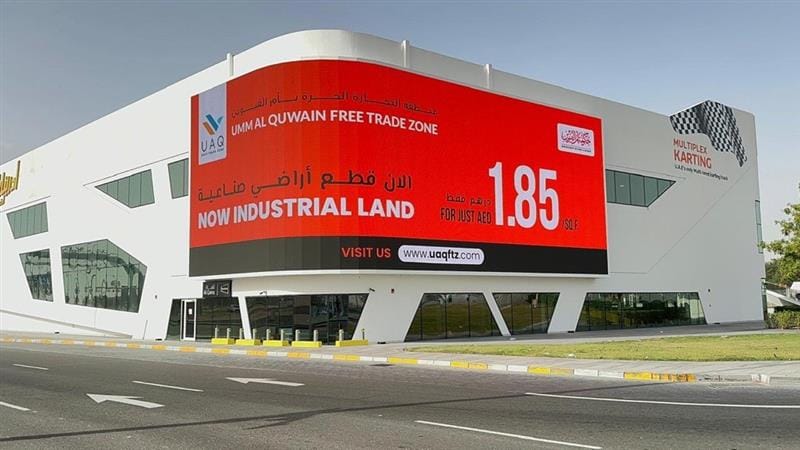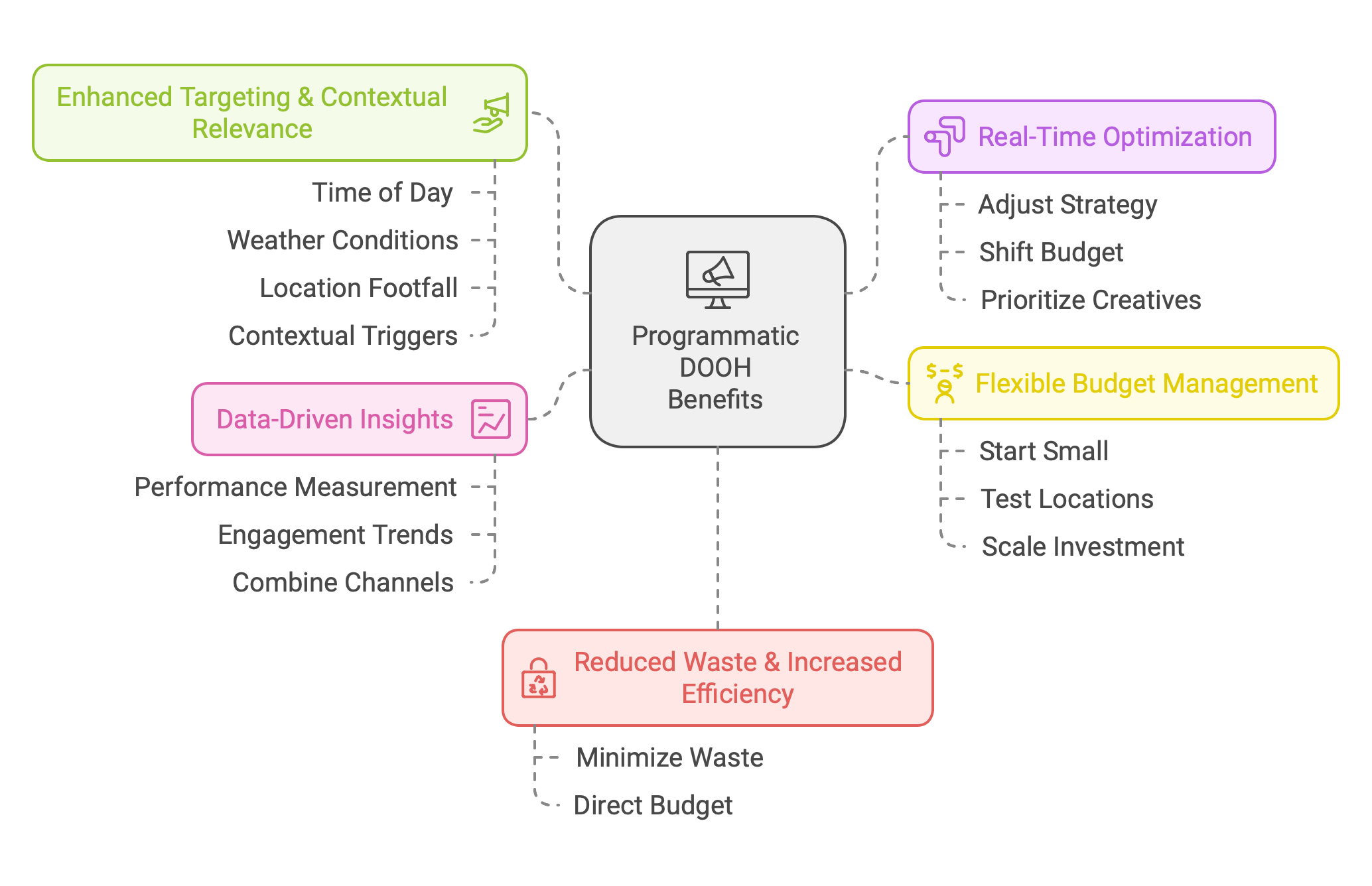As marketing teams around the globe push the boundaries of innovation, programmatic Digital Out-of-Home (P-DOOH) advertising has emerged as a top choice for brands and agencies worldwide.
Let’s explore the evolving world of programmatic Digital Out-of-Home (P-DOOH) advertising. As brands and agencies look for innovative ways to reach audiences in the physical world, programmatic buying has emerged as a powerful method to optimize targeting, flexibility, and measurement. Below, we’ll walk through what programmatic DOOH is, how it differs from traditional digital OOH campaigns, outline the top five benefits of this approach, and then address some common questions.
What is a Programmatic Digital OOH Campaign?
Programmatic Digital Out-of-Home (P-DOOH) advertising is the automated buying, selling, and delivery of ads across out-of-home screens, such as digital billboards, transit displays, and mall signage. Unlike traditional media buying methods—where inventory is purchased in bulk, well in advance—programmatic DOOH uses technology platforms and software to buy ads in real-time, responding to dynamic conditions like audience density, weather, or events. This ensures your brand’s message appears at the right moment, in the right location, to the most receptive audience.


Campaign images from UAQ Free Trade Zones UAE P-DOOH campaign targeting investors in Dubai and Abudhabi's prime locations
How is Programmatic DOOH Different from a Normal Digital OOH Campaign?
Traditional digital OOH campaigns typically involve direct deals with media owners, where advertisers negotiate fixed slots, durations, and pricing beforehand. This method provides certainty but can lock you into predefined schedules and formats.
Programmatic DOOH, however, leverages real-time bidding (RTB) and data-driven targeting. Instead of committing to a single, long-term inventory package, you can select which impressions to purchase, when, and where, based on live conditions. This flexibility means you can optimize your campaign on the fly, adjusting spend, creative, or targeting parameters to enhance performance.
Batik Air Malaysia advertised with us on Dubai's Prime Programatic screens @ prime traffic timings in morning and evening, thus maximising their reach at right timings
Top Five Benefits of Programmatic DOOH

- Enhanced Targeting & Contextual Relevance:
With programmatic DOOH, you can target audiences based on time of day, weather conditions, location footfall, or even contextual triggers like a major sporting event. For instance, if you’re promoting a cold beverage, you can increase your bids during hot afternoons, ensuring your message resonates more effectively. - Real-Time Optimization:
Programmatic platforms enable you to adjust your campaign strategy instantly. If one location is underperforming, you can shift budget to another, or if certain creatives resonate better during lunchtime, you can prioritize those times for maximum impact. - Flexible Budget Management:
No longer are you locked into rigid contracts or expensive long-term bookings. You can start small, test different locations or creative variations, and then scale your investment to the best-performing screens and strategies. - Data-Driven Insights:
Programmatic DOOH platforms offer richer reporting than traditional channels. You can measure performance based on impressions, track audience engagement trends, and even combine these insights with other marketing channels to refine your broader media strategy. - Reduced Waste & Increased Efficiency:
By focusing your spend where and when it counts, you minimize waste. You aren’t paying for guaranteed placements when your target audience is sparse. Instead, you’re directing budget to moments of heightened relevance, ensuring better return on investment.
Common Questions & Answers
Q1: What is the frequency/number of playouts prior to the start of the campaign?
In non-guaranteed programmatic DOOH advertising, specific playouts cannot be guaranteed before the campaign starts. Unlike traditional direct-buy scenarios where you know exactly how many times your ad will run, non-guaranteed programmatic relies on real-time bidding. The number of times your ad appears depends on the inventory available at that moment, your bid prices, and how competitive the market is. In other words, your ad’s frequency and playout volume emerge dynamically once your campaign is live and begins bidding for screen time.
Q2: Can we get Share of Voice (SOV) on our upcoming campaign?
Securing a guaranteed Share of Voice (SOV) in a non-guaranteed programmatic environment is challenging. SOV traditionally means you’ve locked in a certain percentage of ad space over a defined period. In non-guaranteed programmatic buying, inventory is purchased via live auctions. As a result, the exact portion of total impressions you’ll achieve is unpredictable.
However, there are strategic ways to try and boost your effective SOV. You could broaden your targeting parameters—add more screens, diversify your locations, or increase your bid prices—to increase your chances of winning more auctions. While you still won’t receive a guaranteed SOV, these tactics help you maximize visibility across a wider array of screens and time slots.
Q3: What are impressions in Programmatic DOOH?
Impressions in Programmatic DOOH represent the estimated number of people who have the opportunity to see your ad. It’s a measure of audience exposure, where factors like location foot traffic and typical viewing angles are considered. Impressions are often calculated by media owners and industry measurement standards, and may be referred to as “Visibility Adjusted Contact” or “VAC.” In essence, impressions estimate how many eyeballs pass by the screen and could notice the ad.
Q4: What are playouts, and how are they different from impressions?
Playouts are simply the number of times an ad is displayed on a screen. They tell you how frequently your ad is shown but do not account for audience size. For instance, if your ad plays 100 times on a screen, that’s 100 playouts, regardless of how many people actually saw it.
The key difference between impressions and playouts is that impressions provide a sense of potential reach (how many people could see the ad), while playouts represent the volume of times the ad was broadcasted. Impressions focus on the viewer, playouts on the ad delivery itself.
Putting it All Together
Programmatic DOOH is revolutionizing out-of-home advertising by making it more data-driven, flexible, and contextually relevant. While it may introduce new complexities—like the inability to guarantee specific playout volumes or SOV—this approach empowers advertisers to refine their campaigns in real-time, adapt to changing market conditions, and reach audiences with precision.
By understanding the concepts of impressions and playouts, you can measure campaign success more intelligently. And though guaranteed SOV is difficult in a non-guaranteed environment, strategic choices can still improve your chances of widespread exposure.
For today’s brands seeking to meet audiences in the physical world with the adaptability and responsiveness of digital marketing, programmatic DOOH stands as a powerful, forward-thinking option. It blends the strength of location-based storytelling with the agility and measurability of programmatic channels—offering an advertising frontier that marries the tangible impact of outdoor media with the sophistication of modern data-driven buying.

